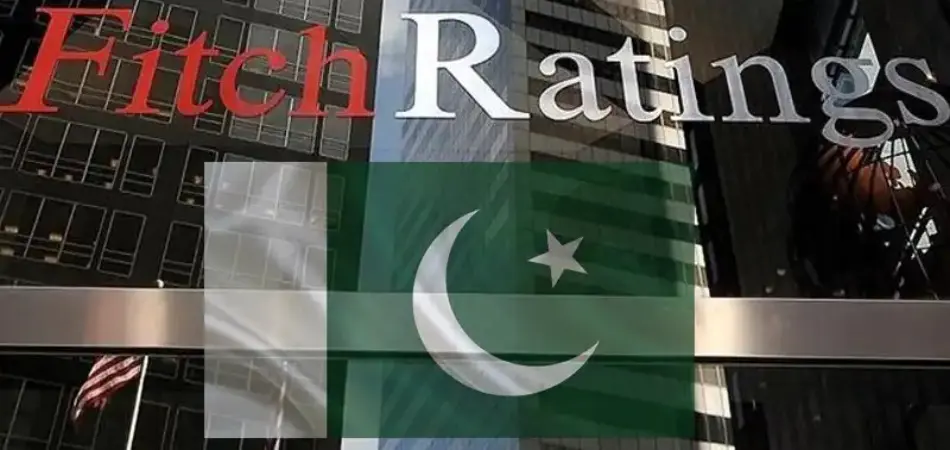Pakistan aims to cut fiscal deficit further: Fitch

MG News | June 13, 2025 at 03:04 PM GMT+05:00
June 13, 2025 (MLN): The draft budget released by Pakistan’s government on 11
June points to further narrowing of the fiscal deficit, following a strong
performance in the fiscal year to June 2025 (FY25), says Fitch Ratings.
Fitch projections are more conservative than the
government’s, given the potential difficulties in implementing planned tax
reforms and a challenging growth outlook.
Still, Fitch now forecasts fiscal consolidation to advance
slightly faster than expected at the time of the upgrade of Pakistan’s rating
to ‘B-’ with a Stable Outlook in April 2025.
The government’s latest estimates suggest Pakistan’s combined federal and provincial fiscal deficit narrowed to 5.6% of GDP in FY25, from 6.9% in FY24.
The government succeeded in raising federal tax revenue,
which was in line with its budgeted target as a share of GDP, though short in
nominal terms given the rapid decline in inflation since June 2024.
The strong fiscal performance also reflected higher non-tax
revenue from the State Bank of Pakistan (SBP), underpinned by SBP repo
operations that have supported commercial banks’ purchases of government debt
at high policy rates.
Meanwhile, the government continued to underspend on the development budget.
|
Pakistan Fiscal Performance (% of
GDP) |
||||
|
Indicator |
FY25 Budget Targets |
FY25 Estimated Outturn |
FY26 Budget Targets |
FY26 Fitch Projections |
|
Federal tax revenue |
10.4 |
10.4 |
10.9 |
10.5 |
|
o/w Provincial share |
6 |
6.1 |
6.3 |
6.2 |
|
Non-tax revenue |
3.9 |
4.3 |
4 |
4 |
|
Federal expenditure |
15.2 |
15 |
13.6 |
14.2 |
|
o/w interest payments |
7.9 |
7.8 |
6.3 |
7.1 |
|
Provincial surplus |
1 |
0.9 |
1.1 |
0.9 |
|
Overall balance |
-5.9 |
-5.6 |
-3.9 |
-5 |
|
Overall primary balance |
2 |
2.2 |
2.4 |
2.1 |
The budget’s estimates for FY25 appear broadly in line with
the revised quantitative performance criteria outlined at the time of the first
review of Pakistan’s Extended Fund Facility with the IMF.
However, tax revenue is still slightly below the programme’s
indicative targets. The next programme review is scheduled for September.
The government expects the deficit to narrow further to 3.9%
of GDP in FY26, mainly due to a sharp drop in interest costs and a further
increase in the tax take from broadening the tax base and improving tax
collection.
Planned increases in defence spending are relatively small
in real terms, as spending was already higher than planned in FY25.
The budget for development spending has been cut, but
development spending is likely to be above the very low levels of FY25, albeit
still insufficient to alleviate structural constraints to Pakistan’s
medium-term growth.
Fitch expects the continued restrictive fiscal settings in FY26 to contain Pakistan’s current account deficit and support a continued build-up of foreign-exchange reserves, helping it cope with ongoing large external debt maturities.
The official FY25 deficit estimate is smaller than the 6% of
GDP that Fitch had assumed in our April assessment.
However, Fitch is less optimistic than the government about
the prospects for fiscal consolidation, and expects the overall deficit to
narrow only to 5% in FY26.
This is partly due to our weaker projections for economic
growth, which Fitch expects will hit 3.5% in FY26, up from an estimated 2.7% in
FY25 but below the government’s 4.2% target.
It also reflects more conservative assumptions about
progress on raising federal tax revenue.
In addition, Fitch thinks the government’s interest costs
will decline more gradually than the budget projects.
The government’s success in hitting the previous budget’s
targets for tax revenue in FY25 points to the potential for Pakistan to
outperform against our fiscal projections.
Nevertheless, implementation risks remain, given the mixed
long-term record of IMF programme execution by governments across Pakistan’s
political spectrum, as well as persistent political and security risks.
The apparent consensus within Pakistan on the need for
reform could weaken over time. Technical challenges, for example, around digitalization,
will also be significant.
Fitch stated in April that positive rating action could
result from significant declines in government debt and debt-servicing burdens,
or further easing of external financing risks.
Meanwhile, failure to keep debt and debt-servicing metrics on a firm downward path, or renewed deterioration in external liquidity, could lead to negative rating action.
Copyright Mettis Link News
Related News
| Name | Price/Vol | %Chg/NChg |
|---|---|---|
| KSE100 | 172,400.73 346.40M | 0.92% 1570.51 |
| ALLSHR | 103,483.96 796.97M | 0.55% 561.58 |
| KSE30 | 52,734.06 184.56M | 1.08% 564.57 |
| KMI30 | 245,565.33 110.97M | 1.07% 2605.02 |
| KMIALLSHR | 67,233.70 319.67M | 0.68% 453.28 |
| BKTi | 47,898.10 95.85M | 0.98% 462.51 |
| OGTi | 33,838.49 13.78M | 1.39% 464.88 |
| Symbol | Bid/Ask | High/Low |
|---|
| Name | Last | High/Low | Chg/%Chg |
|---|---|---|---|
| BITCOIN FUTURES | 87,825.00 | 90,115.00 86,915.00 | 75.00 0.09% |
| BRENT CRUDE | 60.80 | 62.67 60.56 | -1.44 -2.31% |
| RICHARDS BAY COAL MONTHLY | 87.50 | 0.00 0.00 | 1.05 1.21% |
| ROTTERDAM COAL MONTHLY | 94.50 | 0.00 0.00 | -0.70 -0.74% |
| USD RBD PALM OLEIN | 1,027.50 | 1,027.50 1,027.50 | 0.00 0.00% |
| CRUDE OIL - WTI | 56.93 | 58.88 56.65 | -1.42 -2.43% |
| SUGAR #11 WORLD | 15.17 | 15.28 15.08 | -0.12 -0.78% |
Chart of the Day
Latest News
Top 5 things to watch in this week
Pakistan Stock Movers
| Name | Last | Chg/%Chg |
|---|
| Name | Last | Chg/%Chg |
|---|

_20251003092603298_af0c50_20251010094012153_327c07.webp?width=280&height=140&format=Webp)


 MTB Auction
MTB Auction